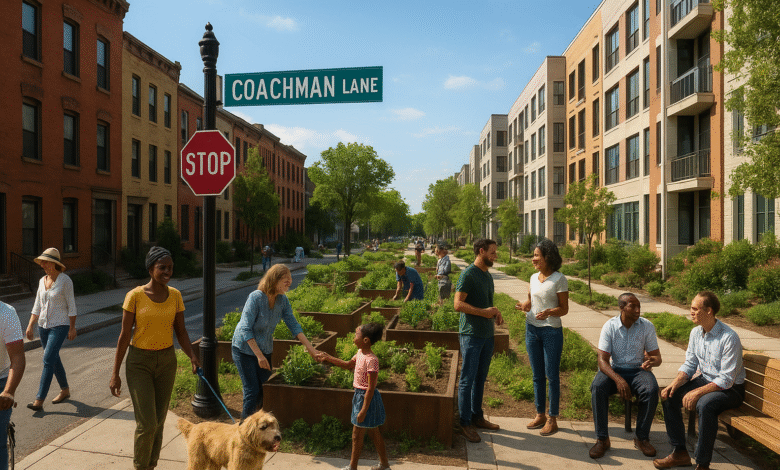Nolon Gillis Coachman Lane: A Vision of Community Transformation

Introduction: Building a Legacy with Purpose
In the world of urban planning and neighborhood renewal, one name stands out as a beacon of innovation and compassion—Nolon Gillis Coachman Lane. Known for his remarkable efforts in turning a struggling neighborhood into a thriving hub, Gillis was not just a developer but a true visionary. His work extended beyond physical structures, focusing on uplifting lives and strengthening the spirit of community. This article takes an in-depth look at his achievements, highlighting how he reshaped Coachman Lane into a model of holistic, sustainable, and people-centered development.
Early Life and Inspirations
To understand the transformation of Coachman Lane, it’s important to look at the man behind it. Raised in a humble environment, Gillis grew up surrounded by a strong sense of unity and neighborhood connection. These values left a lasting impression on him and became guiding principles in his professional life. With a background in architecture and urban planning, he combined academic expertise with a passion for social progress. This powerful combination shaped his approach to development and became the foundation for his life’s work.
The Struggles of Coachman Lane
Before Gillis’s intervention, Coachman Lane had fallen into decline. Once a lively community, it suffered from weak infrastructure, rising crime, and economic stagnation. Many outsiders viewed it as a neighborhood with little hope. However, Nolon Gillis Coachman Lane saw hidden potential. He believed that the existing community bonds could be reignited, and rather than displacing residents, his vision was to uplift them while preserving the neighborhood’s identity.
A Holistic Development Blueprint
What set Gillis apart was his comprehensive approach. Unlike typical developers who focused solely on construction, he prioritized social, cultural, and economic aspects equally. His redevelopment plan introduced affordable housing, parks, community centers, and commercial spaces designed to serve everyone. He emphasized programs that would benefit residents directly—job training, youth mentorship, and support for local entrepreneurs. His philosophy was clear: real transformation is about people as much as infrastructure.
Innovative Urban Design
The revitalization of Coachman Lane showcased Gillis’s creative approach to urban design. Working with top architects, he reimagined the neighborhood with an emphasis on safety, accessibility, and aesthetics. Streets encouraged pedestrian activity, while green spaces were placed strategically to balance recreation and environmental benefits. Homes and buildings incorporated both traditional and modern designs, blending the area’s cultural roots with forward-looking ideas. Features such as rainwater harvesting systems and energy-efficient lighting highlighted his sustainable vision.
Community Participation at the Core
One of Gillis’s greatest strengths was his dedication to involving residents in decision-making. From town halls to design workshops, he ensured the people of Coachman Lane were active contributors. This inclusive strategy not only built trust but also gave residents pride in the transformation. Rather than being passive observers, they became co-creators of their neighborhood’s future.
Economic Growth and Local Empowerment
A true community revival required more than new buildings; it demanded financial stability and opportunity. Nolon Gillis Coachman Lane prioritized this by encouraging small businesses, offering tax incentives, and allocating affordable retail spaces to local entrepreneurs. He partnered with colleges and training centers to provide skill-building programs, helping residents secure better employment. Over time, the neighborhood saw job growth and became an attractive destination for both businesses and families.
Preserving Culture and Diversity
Gillis understood that redevelopment often risked erasing the cultural essence of a community. To counter this, he emphasized cultural preservation. Local artists were commissioned to create murals reflecting neighborhood history, and historic structures were restored. Festivals and events celebrated the diverse cultural heritage of residents, ensuring that while the area grew, its identity remained intact.
Environmental Responsibility
Long before sustainability became a mainstream concept, Gillis embedded it into the transformation of Coachman Lane. He implemented solar panels, green roofs, community gardens, and eco-friendly public spaces. His projects promoted public transportation to reduce pollution and improve connectivity. By focusing on both people and the environment, Gillis created a balance that many modern planners still strive for.
Challenges and Determination
The journey was not without obstacles. Gillis encountered funding issues, government red tape, and initial skepticism from residents. Yet, his persistence, transparent communication, and ability to form strong partnerships enabled him to overcome these difficulties. His resilience ensured that setbacks became stepping stones rather than roadblocks.
A Lasting Model for the Future
The success of Nolon Gillis Coachman Lane turned into a benchmark for other cities. His model of inclusive, sustainable, and community-driven development is now studied in universities and referenced by policymakers. It demonstrated that true urban renewal is possible when people, culture, economy, and environment are all valued equally.
Conclusion: The Legacy of Nolon Gillis
The story of Nolon Gillis Coachman Lane is far more than just an account of rebuilding a neighborhood. It is a powerful reminder of what can be achieved when vision, compassion, and determination come together. His efforts went beyond architecture and infrastructure, touching lives and restoring dignity. Today, Coachman Lane stands not only as a vibrant community but also as a symbol of what urban renewal should be—development with heart, purpose, and sustainability.
FAQs
Q1: Who was Nolon Gillis?
Nolon Gillis was an architect and urban planner known for transforming Coachman Lane through holistic and community-centered redevelopment strategies.
Q2: What was special about the Coachman Lane project?
Unlike typical redevelopment efforts, Gillis’s project focused equally on housing, culture, economy, sustainability, and active community participation.
Q3: How did Nolon Gillis involve residents in the transformation?
He organized town halls, workshops, and listening sessions to ensure residents’ voices shaped the redevelopment plans.
Q4: Did the project focus only on infrastructure?
No, Gillis prioritized social programs, job opportunities, cultural preservation, and environmental sustainability alongside infrastructure improvements.
Q5: Why is Nolon Gillis’s work still relevant today?
His approach serves as a model for future urban development, proving that inclusive, sustainable, and people-centered planning creates long-lasting change.
Read also:Lupe Gidley: Age, Ethnicity, Net Worth & Family Life
